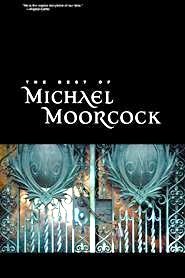 The Best of Michael Moorcock
The Best of Michael Moorcock
Ed. by John Davey
with
Ann & Jeff Vandermeer
Reviewed by Karen L. Newman
Think of science fiction and Great Britain and you might think of Doctor Who. True, that’s been recently on television. However, for literature you should think of Michael Moorcock. For those unfamiliar with this titan of science fiction and fantasy, The Best of Michael Moorcock is a fantastic introduction.
Moorcock takes religion and turns it inside out, not to belittle it, but to expose humanity’s foibles. “Behold the Man” is a controversial masterpiece that merges time travel and religious sacrifice. “A Slow Saturday Night at the Surrealist Sporting Club” personifies God as He answers questions in a most surprising way to hammer home Moorcock’s point. “Lunching with the Antichrist” is a long and drawn-out story that bogs down in places and doesn’t keep the reader’s interest, untypical of Moorcock’s usual skill. However, the theme of don’t judge by appearance is portrayed in a novel way.
Drug use is a common thread that runs through the following collected stories. The shock value is better suited in the time frame in which most were written. “A Dead Singer” is a tribute to a famous American musician via a character who is a “roadie” for the band Deep Fix, the name of Moorcock’s own band. He references the band again in the title of the story “The Deep Fix”, where the writing is strong, but the ending is predictable for this science fiction horror tale. “The Opium General” is a non-genre story about the effects of drug use on a relationship, an average rendition for a very common topic these days.
Moorcock is perhaps best known for his stories about multiverses and alternate realities. In “The Visible Man” Moorcock ponders about having multiple versions of oneself, a very short and ineffective tale. “Colour” is a highly imaginative and stylized story about a gateway to another universe. The writing style here is more verbose compared to today’s standard of literature and thus can take several readings to fully appreciate. “The Birds of the Moon” again involves travel to another universe, but instead concentrates on a man’s regret over a decision and his subsequent emotions. This story is well-crafted and poignant. The tale ends with an epilogue similar to that of a Twilight Zone episode, a ploy in this instance that focuses Moorcock’s point with precision.
Exotic locales are sometimes backdrops to Moorcock’s stories. Three such tales are selected from a set of four dubbed ‘Some Reminisces of the Third World War’. A Russian military liaison is first sent to Canada from England in “Going to Canada”, just before the start of the third world war. This story gives the background of the agent and delves into some of the human condition that precludes the war. “Leaving Pasadena” is a wonderful love story set during the war. The liaison must leave the woman he loves, but he always thinks of her whatever he does. The ending is unexpected. Moorcock’s most famous of the set, “Crossing into Cambodia”, shows the horrors of the war. Moorcock uses the imagery of the jungle to compare to and contrast with humanity. This is one of Moorcock’s finest works. “The Cairene Purse”, not of the set, is told against the backdrop of North Africa and follows a brother’s search for his sister, an archeologist. This is a science fiction masterpiece for the excellent exploration of human relationships and aliens both from outer space and Earth.
The four remaining stories in The Best of Michael Moorcock involve either animals or their bones. “A Portrait of Ivory” is an Elric of Melnibone tale. Here the hero poses for a young woman who has only one medium left in which to work – the bone of a dragon. The story stands alone without the reader having to be familiar with the fantasy kingdom. “A Winter Admiral” is not a genre tale, but contains wonderful imagery normally found in a fantasy story. Marjorie Begg, from a family Moorcock uses often in his work, is not as alone as she thinks one winter. She finds a surprise visitor, full of symbolism. Human greed regardless of ethics is described in “London Bone” where what’s unearthed is not what it seems. The ghastliness of the story showcases the worst of humanity. Moorcock uses symbolism again in “Doves in the Circle”, along with showing the worst of human nature when an old man and young woman exchange secrets in a small neighborhood.
The Best of Michael Moorcock gives the reader a broad overview of the writer’s long career by including stories published from 1964 to 2007. Genre or not, Moorcock tells tales of people – their struggles, decisions, emotions. Moorcock paints a picture of life with his pen and succeeds.
The Best of Michael Moorcock
Ed. by John Davey with Ann & Jeff VanderMeer
Tachyon Publications, May 2009
404 pages; Trade Paperback, $14.95